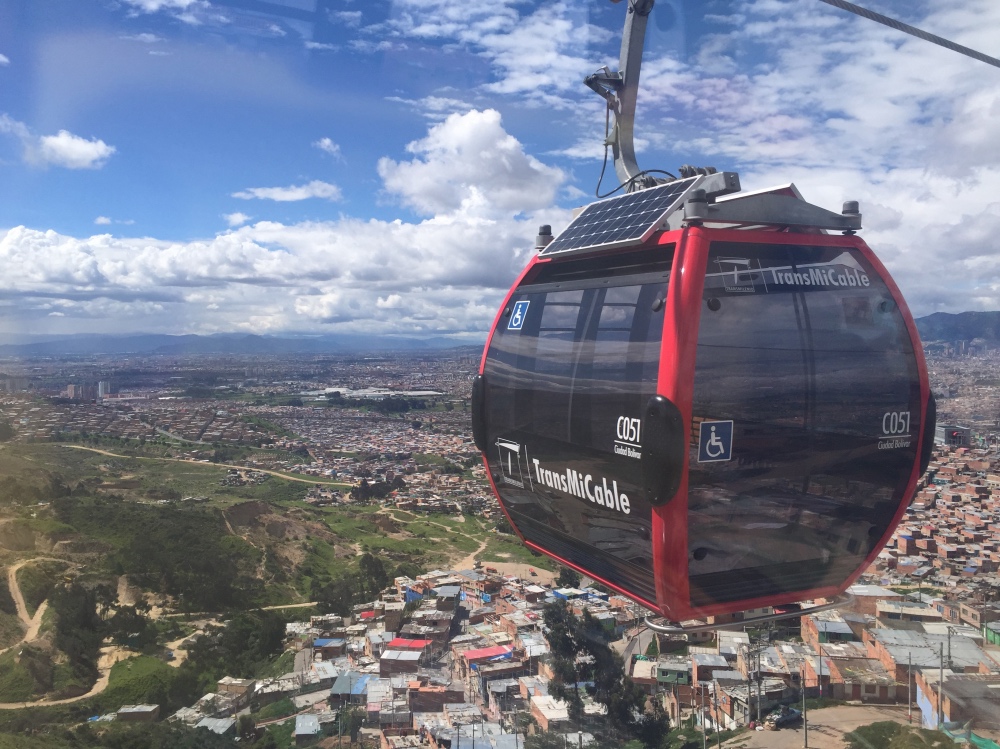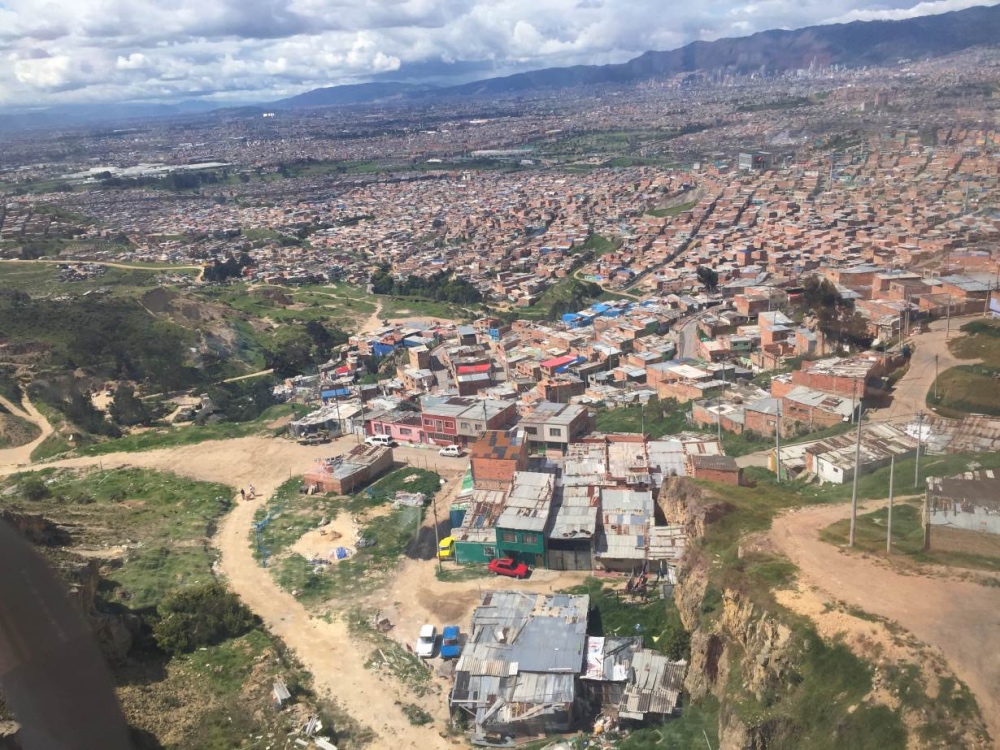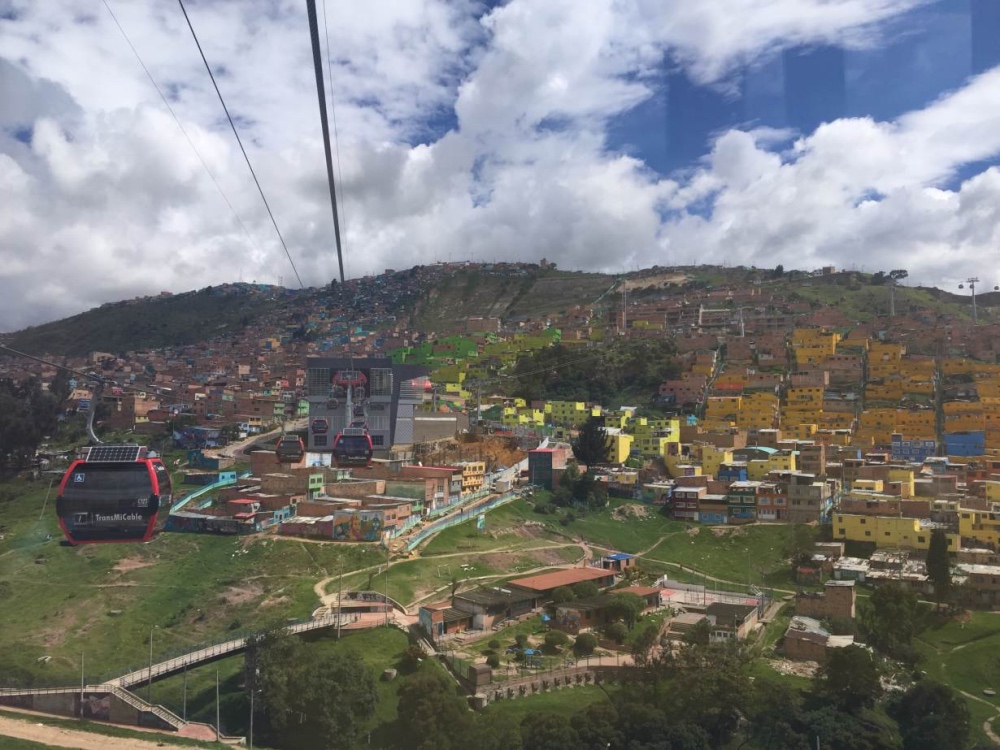
ANASTASIA MOLONEY, of Thomson Reuters Foundation, reports from Colombia…
Bogota, Colombia
Thomson Reuters Foundation
Sweeping above sprawling slums in the upper reaches of one of Bogota’s poorest hillside shantytowns, Yobana Bonella sits comfortably in a solar-powered gondola ferrying thousands of residents up to their homes, leaving almost no carbon footprint.
With two solar panels atop each cable car, the system called “TransMiCable” transports about 20,000 residents a day living in the southern neighbourhood of Ciudad Bolivar, up and down the mountain in under 15 minutes and for less than $1 per journey.
The 3.5 kilometre TransMiCable, launched in December, has not only more than halved journey times but is helping cut traffic congestion, air pollution and planet-warming emissions.
“I’ve really benefited from the TransMiCable because it saves time,” said 38-year-old nanny Bonella, riding a red cable car on her way home from work. “Each wagon has solar panels which I think is nice – it helps to conserve the environment.”

A car of the solar-powered TransMicable system runs above Ciudad Bolivar in Bogota, Colombia, on 5th June. PICTURE: Thomson Reuters Foundation/Anastasia Moloney
Lacking a train or metro system and with electric cars yet to take off, fume-belching buses clog up Bogota’s streets. Expanding the availability of fast, clean-energy transport is a priority for Colombia’s capital city of eight million people.
Worldwide, cities account for about three-quarters of carbon emissions and consume more than two-thirds of energy, meaning their success or failure in reducing emissions will have a big impact on whether global warming can be kept to agreed limits.
“I’ve really benefited from the TransMiCable because it saves time. Each wagon has solar panels which I think is nice – it helps to conserve the environment.”
– Bonella, a 38-year-old nanny, who uses the cable car to get to work.
Burning fossil fuels for power, transport and industry is the main source of the emissions that are heating up the Earth’s climate, as well as a major contributor to air pollution.
With Latin American cities struggling to stem health-harming pollution, introducing cleaner transport that also brings down emissions is a strategy gaining support among policy makers.
Bogota’s four-station cable car follows similar well-received projects in other Colombian cities, from Medellin’s pioneering MetroCable launched in 2004 – the world’s first – to more recent gondolas operating in Cali and Manizales.
Yaneth Mantilla, head of the government’s Institute of Urban Development, which led the construction of TransMiCable, said the design took into account environmental protection.
“One of the most important challenges in any infrastructure or road project is how to generate as little impact as possible, and we achieved this,” Mantilla said.
The power generated by the solar panels on each cabin enables the cable car to operate for five or six hours day without using any other source of electricity, she said.
With the combination of solar and other electricity – about 70 per cent in Colombia is sourced from hydropower – the cable cars are helping avert emissions from fossil fuel used for transport.
“The TransMiCable project not only saves energy but also conveys an environmentally sustainable message to citizens,” said Kristtian Rada, head of the Latin America cities programme at the World Bank Group’s International Finance Corporation, which plans to help fund the cable car.
Until recently, Ciudad Bolivar residents spent about two hours a day using up to three different buses to get to and from work.
“There’s a reduction in carbon emissions precisely because of the reduction in transportation time,” Rada said.

Informal housing is pictured on the slopes of Ciudad Bolivia neighbourhood in south Bogota, Colombia, on 5th June. PICTURE: Thomson Reuters Foundation/Anastasia Moloney
Government authorities are now assessing the impact of the TransMiCable in cutting emissions and boosting economic growth in Ciudad Bolivar, home to about 700,000 people, he said.
Expanding green transport in the capital and quantifying its success is an urgent task, urban experts have argued.
Even with measures to ease Bogota’s gridlock – including licence-plate restrictions barring cars from roads in peak hours twice a week – dirty air is a growing concern in the city.
“People from Ciudad Bolivar were very isolated. Today they feel involved and part of the city.”
– Yaneth Mantilla, head of the government’s Institute of Urban Development.
Tin-roofed shacks cram entire hillsides in south Bogota, home to more than a third of the capital’s residents, many of them displaced families who fled their rural homes to escape fighting during Colombia’s half-century war.
Bogota’s first cable car connects those poor communities with the rest of the city and its bus network.
“People from Ciudad Bolivar were very isolated,” IDU’s Mantilla said. “Today they feel involved and part of the city.”
For resident Bonella, the gondola has helped instill a sense of pride among locals in an area known for crime and violence.
“It shows the good side of Ciudad Bolivar – and the views are pretty,” she said.
Challenges included buying the land needed to build cable-car stations and pylons, and gaining the trust of communities.
Mantilla said it had been hard to convince local people to “believe once again in institutions”, as they felt neglected by the state which had never before offered transport options.

Cable cars of the solar-powered TransMicable system runs above Ciudad Bolivar in Bogota, Colombia, on 5th June. PICTURE: Thomson Reuters Foundation/Anastasia Moloney
Worldwide, green investments in cities – from electric vehicles to low-carbon buildings – will be crucial if nations are to reduce emissions enough to keep global warming to “well below” two degrees Celsius, as agreed in the 2015 Paris accord.
According to the IFC, energy-efficient public transport in emerging markets could attract $US1 trillion over the next decade, while electric vehicles could see $US1.6 trillion in investment.
Meanwhile, in recent years, other Latin American cities have followed Colombia’s lead on cable cars as a means of efficient green transport in poor city neighbourhoods, launching similar projects from Mexico City to La Paz in Bolivia.
More gondolas are expected to transform the urban skyline in Colombian cities and beyond, from Quito to Lima, Rada said.
But a shortage of government funding means Bogota’s TransMiCable is unlikely to be expanded to other nearby poor districts anytime soon, Mantilla said.
Back on the cable car, approaching the highest station of Paradise Viewpoint, Bonella said the system should be expanded.
“Others living in far away neighbourhoods of Ciudad Bolivar should also get the chance to benefit,” she added.






